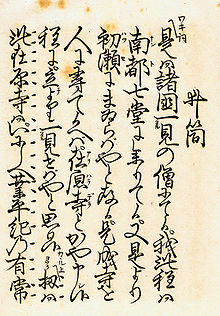
Izutsu
Encyclopedia
- This article refers to the Noh play. Izutsu may also refer to an Izutsu stableIzutsu stableis a stable of sumo wrestlers, part of the Tokitsukaze group of stables.The stable was established in the Meiji era by former yokozuna Nishinoumi Kajirō I, the 16th yokozuna, who became the 7th Izutsu-oyakata. He was succeeded by Nishinoumi Kajirō II, the 25th yokozuna...
, a sumo wrestling stable, or an Izutsu-oyakataIzutsu (toshiyori)Izutsu is a toshiyori . The name is currently held by former sekiwake Sakahoko Nobushige. He is correctly addressed as Izutsu-oyakata.- Holders :*Stable owners in bold.-External links:*...
, a sumo elder.
is a classic Noh play written by Zeami, the dominant figure in the early history of Noh
Noh
, or - derived from the Sino-Japanese word for "skill" or "talent" - is a major form of classical Japanese musical drama that has been performed since the 14th century. Many characters are masked, with men playing male and female roles. Traditionally, a Noh "performance day" lasts all day and...
theatre.
Izutsu is based on an old story, Tsutsu-Izutsu (筒井筒), from the Ise monogatari, a 10th century collection of stories, many of which are based on stories about the romantic encounters of a "certain man", traditionally identified as the poet Ariwara no Narihira
Ariwara no Narihira
was a Japanese waka poet and aristocrat. He was one of six waka poets referred in the preface in kana to Kokin Wakashū by Ki no Tsurayuki, and has been named as the hero of The Tales of Ise, whose hero was an anonym in itself but most of whose love affairs could be attributed to Narihira.He was the...
.
Tsutsu-Izutsu
A boy and a girl knew each other from early childhood. They were good friends, and one of their games was to see who was taller by measuring each other against the local well. As they grew older, they began to feel more self-conscious in each other's company, and they drifted apart, although they continued to love each other.The girl's parents offered to find her a husband
Omiai
or is a Japanese traditional custom in which unattached individuals are introduced to each other to consider the possibility of marriage. Since this "Miai" or "Omiai" was sometimes translated as "arranged marriage" in English and other foreign languages, which is a total misnomer, some foreigners...
. But she declined, because she still had feelings for the boy.
The boy eventually composes a tanka
Waka (poetry)
Waka or Yamato uta is a genre of classical Japanese verse and one of the major genres of Japanese literature...
:
- 筒井筒 井筒にかけし まろがたけ 生いしけらしな 妹見ざる間に
- The wooden frame [of the well]... I was shorter than the frame [when we last compared our heights], but I have outgrown it in your absence.
The girl replies:
- くらべこし ふりわけ髪も 肩過ぎぬ 君ならずして 誰かあぐべき
- We compared the lengths of our hair also. But my hair has grown past my shoulders. If not you, who will be there to tie it up for me?
And so it was that they were married.
However, the man later fell in love with another woman, who lived behind Mount Tatsuta, and he took to making visits to this woman's house. After many visits, the affair could no longer be kept a secret; but his wife made no protest. He concluded that his wife had herself fallen in love with another man.
One stormy night, he was just setting out on one of these visits, when he decided to turn back to find out the identity of his wife's lover. Peeping into the house, he saw that his wife was all alone. Unaware that he was watching, she was applying her make-up and composing a tanka:
- 風吹けば おきつ白波 龍田山 夜半にや君が 一人越ゆらん
- The sea near Mount Tatsuta becomes rough when the wind is so gusty. That my husband should be climbing Tatsuta on such a stormy night! [So, I'm anxious about my husband.]
He realised then how much he was loved, and never went back to the other woman.
Izutsu

Nara, Nara
is the capital city of Nara Prefecture in the Kansai region of Japan. The city occupies the northern part of Nara Prefecture, directly bordering Kyoto Prefecture...
. On his way to Hatsuse, he stops at Ariwara Temple, and recognises the locale as Isonokami, where Narihira and Ki no Aritsune's daughter lived long ago.
A village woman arrives to tend a grave in the garden. She draws offertory water from a wooden-framed well, and, as he watches her, the priest becomes intrigued. He asks her why she is tending the grave and she says there is a story behind the place. She begins to tell the story Tsutsu-Izutsu from the Ise Monogatari.
When she has finished the story, the village woman looks at the priest and says she is the wife in the old 10th century story. She disappears. He has seen her ghost. The priest asks a village man about the place and hears the story more plainly. The villager suggests that, as a priest, he could offer a prayer to her soul, and so he decides to settle down for the night on a bed of moss in the garden. She comes to him again in a dream. This time she is wearing her husband's cap and gown over her kimono. She dances, and sings about how much she loves her husband and how much she yearns for him. She looks into the well that they had stood beside as children and sees his reflection. She then cries and disappears.
External links
- Noh plays Photo Story and Story Paper
- Izutsu Japanese cite, but there are some photos.

